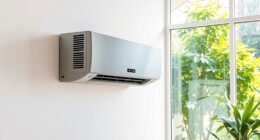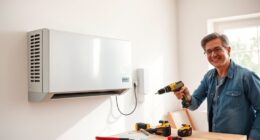Are you ready to delve into the basic principles of the heat pump refrigeration cycle? Join us as we explore the intricate details of this fascinating process.
From the evaporator to the compressor, and the condenser to the expansion valve, we will unravel the secrets of each component.
By understanding the fundamentals, we can optimize the efficiency of the heat pump refrigeration cycle and serve others with our newfound knowledge.
Get ready to master the basics and become a heat pump expert!
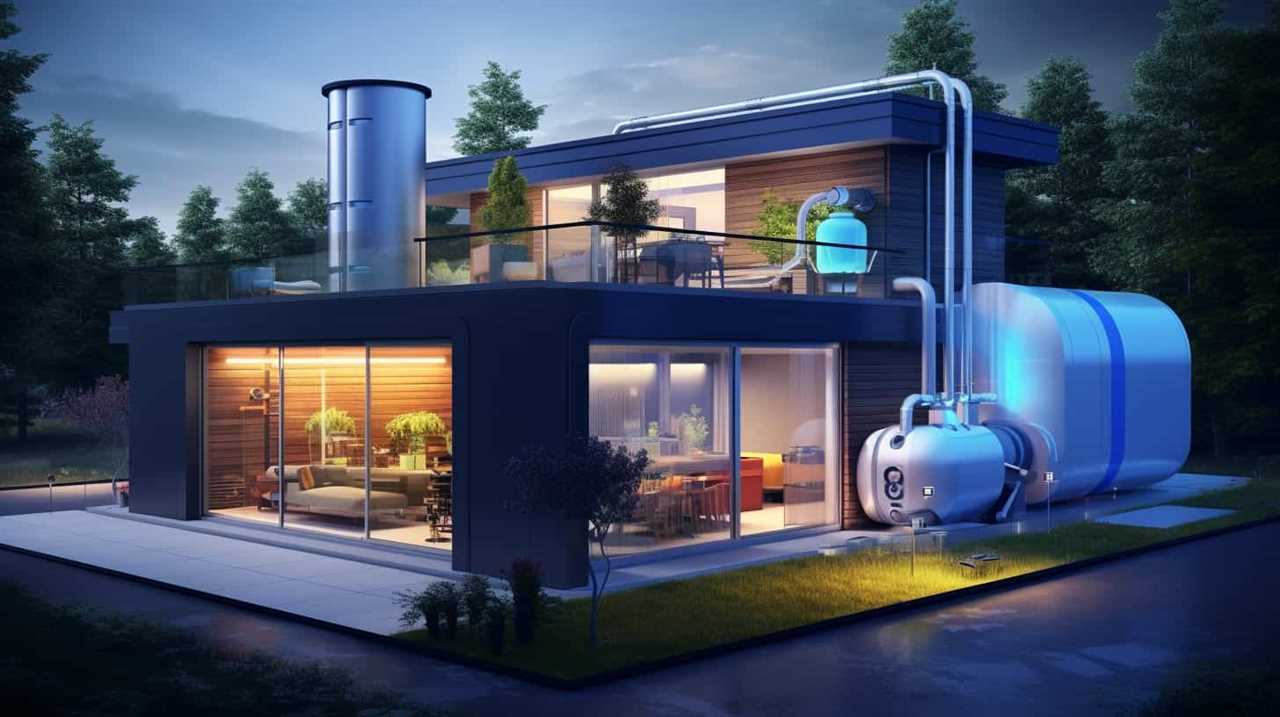
Key Takeaways
- The heat pump refrigeration cycle consists of four essential components: evaporator, compressor, condenser, and expansion valve.
- The efficiency of the evaporator depends on factors such as surface area, temperature difference, and refrigerant flow rate.
- The design of the evaporator greatly affects its performance in the refrigeration cycle.
- Proper sizing of the evaporator is crucial for optimal performance.
Overview of the Heat Pump Refrigeration Cycle
Let’s start by understanding the basics of the heat pump refrigeration cycle. In this cycle, the evaporator plays a crucial role in the operation of the system.
The evaporator is where the refrigerant absorbs heat from the surroundings, such as the air or water, and undergoes a phase change from a liquid to a gas. This process is known as evaporation.
As the refrigerant evaporates, it extracts heat energy from the surroundings, cooling them in the process. The refrigerant then flows through the system, driven by a compressor, to the condenser where it releases the heat it absorbed during evaporation.
Understanding the operation of the evaporator and the refrigerant flow is essential to comprehending the heat pump refrigeration cycle.

Now, let’s dive deeper into understanding the role of the evaporator in the refrigeration cycle.
Understanding the Role of the Evaporator in the Refrigeration Cycle
As we continue to explore the fundamentals of the heat pump refrigeration cycle, it’s crucial to understand the vital role of the evaporator.
The evaporator serves the function of absorbing heat from the surrounding environment, allowing the refrigerant to evaporate and transition from a low-pressure liquid to a low-pressure gas.
The efficiency of the evaporator depends on various factors, such as its surface area, the temperature difference between the refrigerant and the environment, and the flow rate of the refrigerant.

Additionally, the design of the evaporator plays a significant role in determining its performance and overall effectiveness in the refrigeration cycle.
Evaporator Function and Purpose
Our understanding of the refrigeration cycle is incomplete without comprehending the function and purpose of the evaporator.
The evaporator plays a crucial role in the cycle by facilitating heat transfer and allowing for the cooling process to occur. Its primary function is to absorb heat from the surrounding environment, which causes the refrigerant inside the evaporator coils to evaporate.
This phase change of the refrigerant from a liquid to a gas absorbs large amounts of heat energy. To ensure optimal performance, the evaporator must be properly sized to match the cooling load of the system.

This involves considering factors such as the desired temperature differential, the rate of heat transfer, and the flow rate of the refrigerant. By understanding the importance of evaporator performance and sizing, we can proceed to explore the various efficiency factors that impact its overall effectiveness in the next section.
Evaporator Efficiency Factors
Now, let’s delve into the factors that affect the efficiency of the evaporator in the refrigeration cycle.
The evaporator plays a crucial role in the heat transfer process, and optimizing its performance is essential for efficient refrigeration.
Here are three key factors that impact evaporator efficiency:
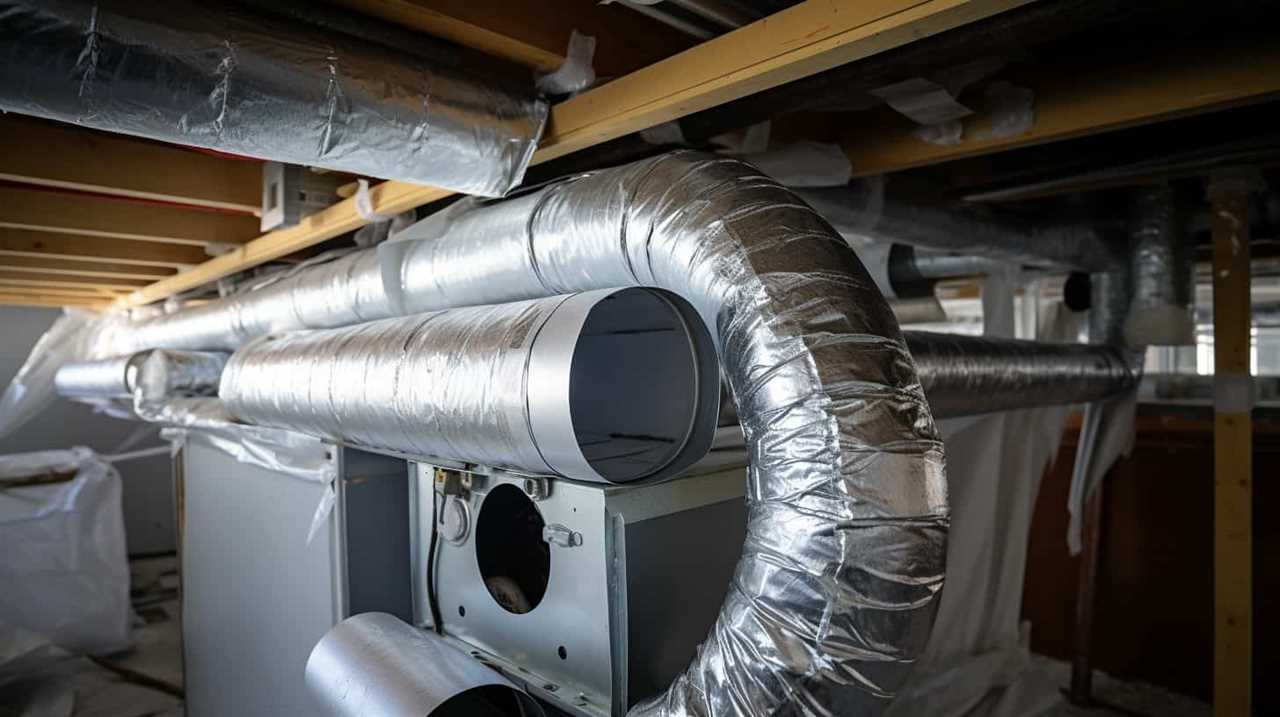
-
Surface area: The larger the evaporator’s surface area, the greater its capacity to absorb heat from the surroundings. By maximizing the surface area, we can enhance the evaporator’s ability to transfer heat effectively.
-
Refrigerant flow rate: Proper refrigerant flow through the evaporator is crucial for efficient heat transfer. If the flow rate is too low, the evaporator may not be able to absorb enough heat. Conversely, if the flow rate is too high, the refrigerant may not have enough time to exchange heat with the surroundings.
-
Airflow: Adequate airflow across the evaporator coils is essential for efficient heat transfer. Proper ventilation ensures that the heat absorbed from the surroundings can be effectively transferred to the refrigerant.
Impact of Evaporator Design
Maximizing the efficiency of the evaporator in the refrigeration cycle requires understanding the role of the evaporator and optimizing its design. The evaporator plays a crucial role in the heat pump system by facilitating the heat transfer process.

It’s designed to absorb heat from the surroundings and transfer it to the refrigerant. The performance of the evaporator greatly depends on its design features, such as the surface area, fin type, and refrigerant flow rate. Increasing the surface area of the evaporator enhances its heat transfer capability, allowing for efficient cooling or heating of the space.
Additionally, using fins on the evaporator surface increases the surface area for heat transfer, further improving the evaporator’s performance. Optimizing the refrigerant flow rate within the evaporator is also essential to ensure efficient heat transfer and maintain a balance between pressure drop and heat transfer effectiveness.
The Importance of the Compressor in the Heat Pump Refrigeration Cycle
The compressor plays a crucial role in the heat pump refrigeration cycle by compressing the refrigerant gas to increase its temperature and pressure. This allows for efficient heat transfer by increasing the temperature and pressure of the refrigerant gas, enabling the heat pump to effectively absorb heat from the source and release it to the desired location. This ensures optimal heating or cooling. A properly functioning compressor also ensures energy efficiency in the heat pump system by reducing the energy required to achieve the desired temperature. Additionally, the compressor plays a vital role in the overall performance of the heat pump refrigeration cycle by ensuring the proper circulation of the refrigerant throughout the system, maintaining the desired temperature levels, and ensuring consistent and reliable operation.
With the compressor’s important role in mind, let’s now explore the function of the condenser in the refrigeration cycle.
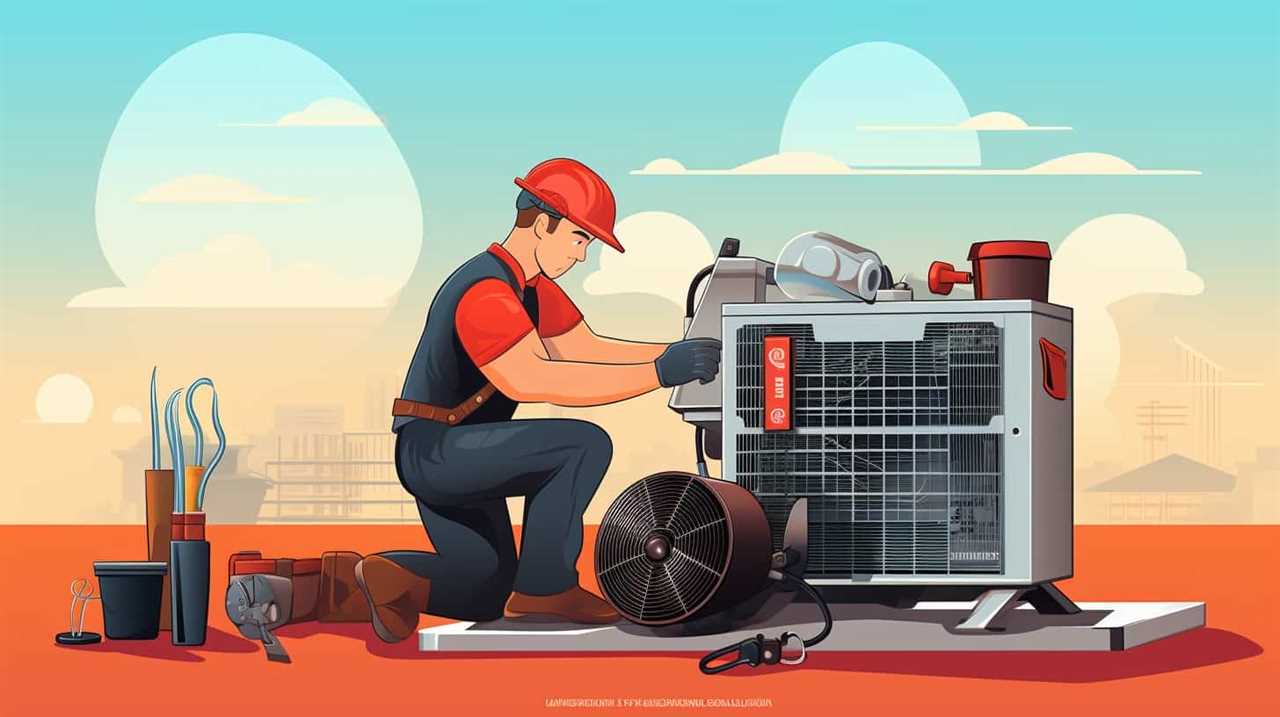
Exploring the Function of the Condenser in the Refrigeration Cycle
We frequently rely on the condenser in the refrigeration cycle to efficiently transfer heat from the refrigerant gas to the surrounding environment. The condenser plays a crucial role in the overall efficiency of the refrigeration system. Its design is optimized to maximize heat transfer and minimize energy consumption.
The condenser is typically made of copper or aluminum tubes with fins to increase the surface area for heat exchange. As the high-pressure refrigerant gas flows through the condenser, it’s cooled down by the ambient air or water, causing it to condense into a liquid state. This heat transfer process releases the heat absorbed in the evaporator, completing the cycle.
The efficiency of the condenser is influenced by factors such as the surface area, refrigerant flow rate, and the temperature difference between the refrigerant and the environment. Proper condenser design is essential to ensure optimal heat transfer and system performance.
Key Components of the Expansion Valve in Heat Pump Refrigeration Cycle
The expansion valve is a crucial component in the heat pump refrigeration cycle. It plays a vital role in regulating the flow of refrigerant from the high-pressure side to the low-pressure side of the system.

Importance of Expansion Valve
One of the key components in the heat pump refrigeration cycle is the expansion valve, which plays a vital role in regulating the flow of refrigerant. The importance of the expansion valve can’t be overstated, as its efficiency directly affects the overall performance of the heat pump system.
Here are three reasons why the expansion valve is crucial in the refrigeration cycle:
-
Expansion Valve Efficiency: A properly functioning expansion valve ensures that the refrigerant is expanded to the right pressure and temperature as it enters the evaporator. This optimal expansion allows for efficient heat transfer and maximizes the system’s cooling capacity.
-
Improved Energy Efficiency: The expansion valve helps maintain the right amount of refrigerant flow, preventing overfeeding or underfeeding of the evaporator. This precise control reduces energy consumption and increases the overall energy efficiency of the heat pump system.

-
Expansion Valve Troubleshooting: When troubleshooting issues in a heat pump refrigeration cycle, the expansion valve is often a key area to investigate. Problems such as clogs, leaks, or improper adjustment can lead to reduced system performance. Regular inspection and maintenance of the expansion valve are essential for identifying and resolving any issues promptly.
Function of Expansion Valve
When operating in a heat pump refrigeration cycle, the expansion valve functions to regulate the flow of refrigerant, ensuring efficient heat transfer and maximizing cooling capacity. The expansion valve is a key component in this cycle, responsible for controlling the amount of refrigerant that enters the evaporator.
It operates by creating a pressure drop across a small orifice, causing the refrigerant to expand and cool down. This process allows the refrigerant to absorb heat from the surrounding environment and carry it back to the compressor for further cooling.
The efficiency of the expansion valve is crucial for the overall performance of the heat pump system. A properly functioning expansion valve ensures that the refrigerant flow is optimized, preventing any unnecessary pressure build-up or loss, and allowing for efficient heat exchange.
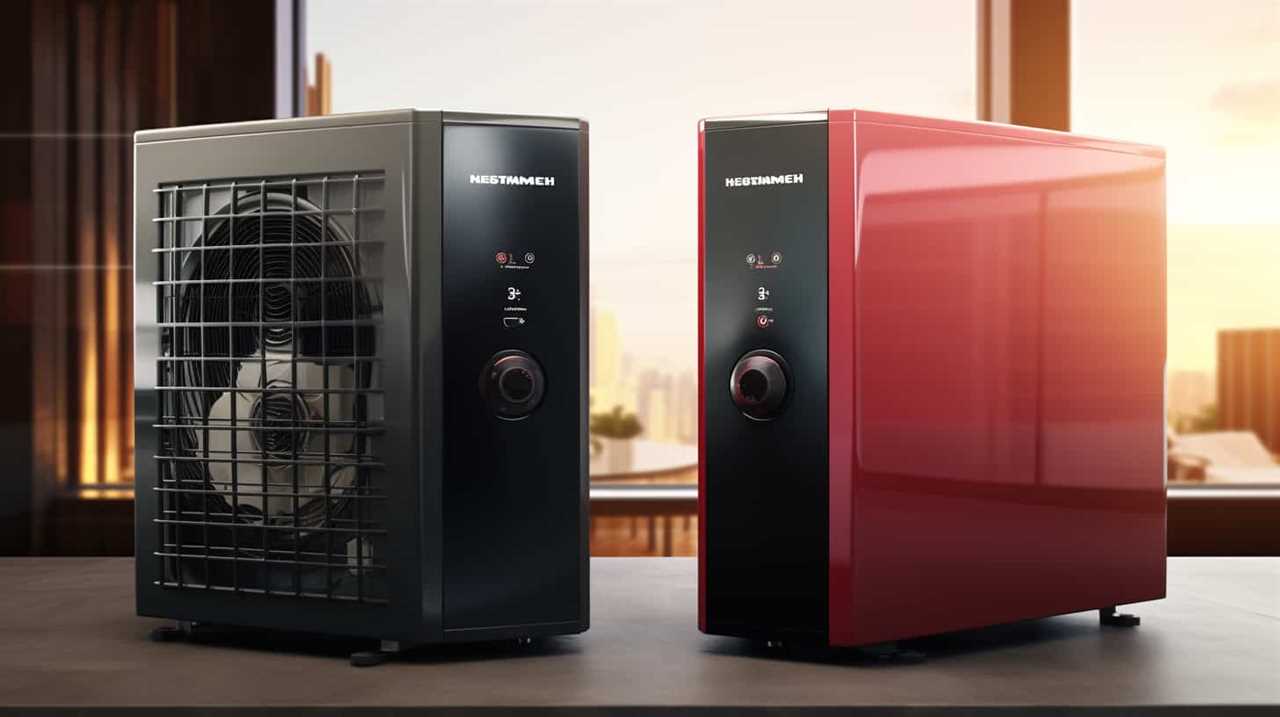
Steps to Optimize the Efficiency of the Heat Pump Refrigeration Cycle
To optimize the efficiency of the heat pump refrigeration cycle, we can follow these steps:
-
Regular Maintenance: Regularly inspect and clean the system components to ensure optimal performance. This includes cleaning the condenser and evaporator coils, checking refrigerant levels, and inspecting electrical connections. By maintaining the system, we can maximize its efficiency and prevent potential breakdowns.
-
Proper Insulation: Properly insulating the refrigerant lines and the surrounding areas can minimize heat transfer and improve the overall efficiency of the heat pump. Insulation helps to maintain the desired temperature inside the system and prevents energy losses.
-
Optimal Sizing: Ensuring that the heat pump is properly sized for the specific application is crucial for maximizing performance. A heat pump that’s too small will struggle to meet the heating or cooling demands, while an oversized heat pump will cycle on and off frequently, leading to energy wastage. Proper sizing ensures efficient operation and optimal energy consumption.

Frequently Asked Questions
How Does the Heat Pump Refrigeration Cycle Work in Different Climate Conditions?
In different climate conditions, the heat pump refrigeration cycle adapts to optimize performance. It efficiently transfers heat from a low-temperature source to a high-temperature sink, providing both heating and cooling capabilities.
What Are Some Common Issues or Problems That Can Occur in the Heat Pump Refrigeration Cycle and How Can They Be Resolved?
Common issues in the heat pump refrigeration cycle can include refrigerant leaks, compressor failure, and inadequate airflow. These problems can be resolved by repairing the leaks, replacing the compressor, and cleaning or replacing air filters.
How Does the Heat Pump Refrigeration Cycle Compare to Other Cooling and Heating Systems in Terms of Energy Efficiency?
The heat pump refrigeration cycle offers potential benefits in terms of energy efficiency compared to other cooling and heating systems. It has a lower environmental impact and can provide both heating and cooling capabilities.
Are There Any Safety Precautions or Maintenance Tasks That Homeowners Should Be Aware of When Using a Heat Pump Refrigeration Cycle?
When using a heat pump refrigeration cycle, homeowners should be aware of safety precautions and maintenance tasks. These include regularly checking and cleaning the filters, inspecting the outdoor unit for debris, and scheduling professional maintenance visits.

Can the Heat Pump Refrigeration Cycle Be Used for Both Residential and Commercial Applications?
Yes, the heat pump refrigeration cycle can be used for both residential and commercial applications. However, there are advantages and disadvantages to consider. Let’s explore the technical details and benefits of using this cycle in various settings.
Conclusion
In conclusion, mastering the fundamentals of the heat pump refrigeration cycle is crucial for optimizing its efficiency. Understanding the roles of the evaporator, compressor, condenser, and expansion valve is key to ensuring smooth operation.
By carefully managing these components, we can unlock the full potential of the heat pump refrigeration cycle and achieve superior cooling performance.
So, let’s dive into the intricate world of refrigeration and embrace the beauty of its technical precision.







